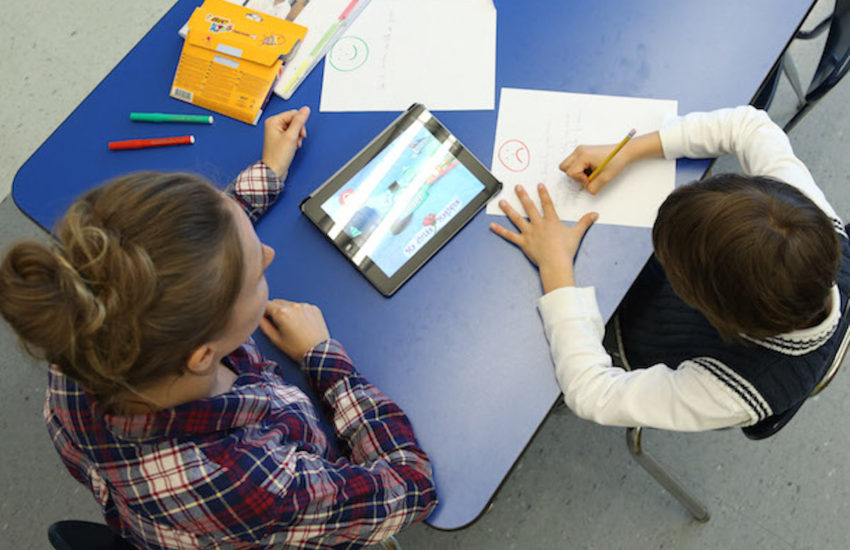This article is from the 2015 issue of the LFNY Magazine.
Every year in the fall, first and second graders learn how to perform circus-themed activities in the school’s phys-ed (PE) program. “It’s a workshop I especially like because it combines physical exercise with artistic elements and play acting,” says Annabelle Altefrohne, a primary PE teacher, who started the activity shortly after her arrival at the Lycée Français in 2012. Mrs. Altefrohne, one of the school’s 15 technology ambassadors, has found a way to use technology to improve even the PE program, and it all started with a problem she observed.
For two months, the children learn eleven “circus” exercises, including work with an exercise ball, ribbon dance, and tall stilts. PE teachers were using flash cards with illustrations of each exercise as a learning tool. “The children were not looking at them,” she explains. “The cards were not very motivating, because the characters were static and the sequencing of the movements was sometimes difficult to follow.”
Mrs. Altefrohne used the iPad to create short videos illustrating each exercise. The teachers filmed the students performing each activity, and the students were fascinated by the videos, which they could watch as often as they wanted on their own.
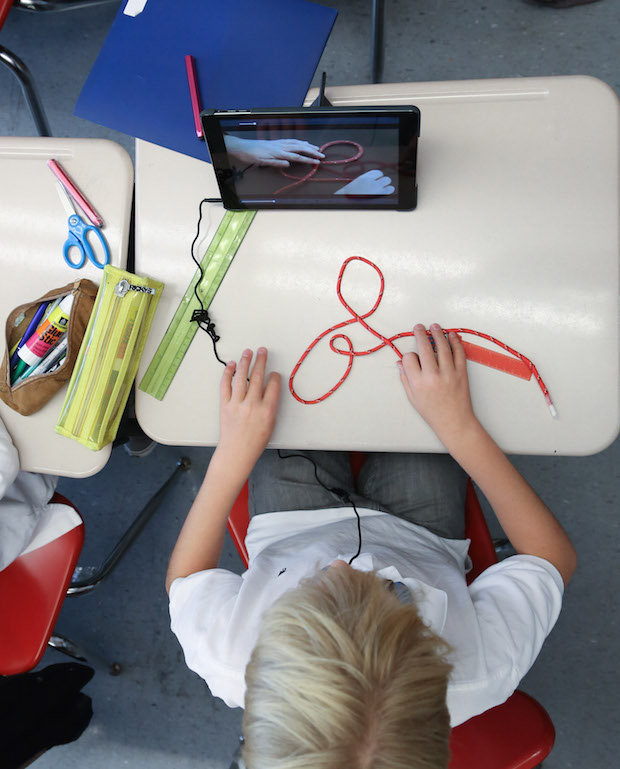 “We have four levels of difficulty for each of the eleven workshops so this meant producing 44 videos!” she points out. “Seeing their classmates in the videos encouraged them to try even harder,” she says.
“We have four levels of difficulty for each of the eleven workshops so this meant producing 44 videos!” she points out. “Seeing their classmates in the videos encouraged them to try even harder,” she says.
Mrs. Altefrohne worked in collaboration with other members of the PE primary team to create a simple iPad app for all the videos that made them easy to update for use year after year. “This is an example of the successful use of technology in the classroom based, first and foremost, on the needs of a given course,” notes Adena Dershowitz, Director of Digital Learning at the Lycée, who is spearheading school-wide integration of technology into the classrooms.
“Whispering”
Since the iPad appeared at school in 2012, it has gradually taken a place in the primary classrooms. In 2014-2015, two English teachers used the tool in a joint project that brought together students in pre-K and in the second-grade English-language learning program for students new to the U. S. The second graders were tasked with recording their voices reading books aloud to pre-kindergarteners.
“At first the second graders, who were learning English as a second language, whispered when they were recording on the iPad,” recalls Abby Berkelhammer, who taught elementary English. She used the Puppet Pal app, which allows stories to be told in the form of playful cartoons. “The cartoons were more playful, and this gave more confidence to students, who were, at first, self-conscious when speaking English.”
“The key is balance, finding what tool is best suited for a student and a specific lesson,” Adena Dershowitz, Director of Digital Learning.
One of the Lycée’s strategic objectives for the next five years is to enrich learning with the help of information technology. “The world is increasingly dependent on technology, and it is our role as an educational institution to give our students the skills they need to thrive in it,” says Mrs. Dershowitz.
“We cannot stay in a bubble, resisting change,” adds Vannina Boussouf, who directs the Primary School. “We must accompany students – and teachers – into this new world where technology is everywhere.” New technological tools (computers, iPads, Smartboards, Apple TV) however, are not a panacea. “The key is balance,” adds Mrs. Dershowitz, “and that means finding which tool is best suited for a student and a specific lesson.”
Collaborative learning and self-esteem
One of the key benefits of technology in the classroom is fostering collaboration among students. Teacher Mylène Ardid used the iPad Subtext app (now known as AR360) in her fifth-grade class, because it allows students to work independently or in groups on the same text. She likes being able to let her students learn from their mistakes and to help each other by correcting their classmates’ written work.
“It’s much less teacher-centered, and our students are more in charge of their own learning,” she says. However, she is also careful to step back from these new tools, when they aren’t needed. “We have to always question if our use of technology makes sense for a particular lesson and choose the best tool,” she says, paraphrasing the technology education expert, Marc Prensky, who presented to faculty and staff during their August orientation in 2014.
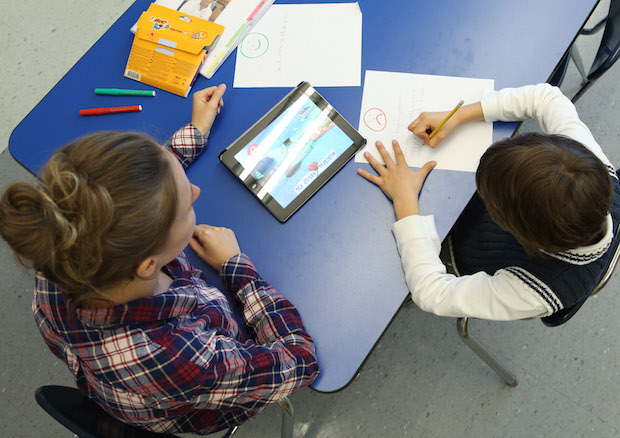
Technology has proven to be a veritable revelation for students with learning challenges. “The iPad is playful, and we can tap that to engage students more fully with their school work,”says Caroline Rys, one of two Primary teachers for students with learning challenges (RASED). In her class, she uses the iPad regularly with her students to search for word definitions with images (often more beneficial), or to dictate words for voice recognition in search (to help youngest students to find a text they are looking for without mastering writing), as well as for its education apps. She says that game-based apps have the advantage of motivating students and helping them to accept their mistakes more easily. “Because it’s not the teacher or the parent who points them out, but rather the app,” she adds.
Ms. Rys, who works with some 25 students each year, finds that the working on the iPad can help children regain confidence that might have been shaken by their difficulties in the classroom. She records and photographs the children to document their progress. “I have them verbalize the methods they used to be successful at a given exercise so they can observe their own progress and use similar strategies outside of my classroom,” she explained.
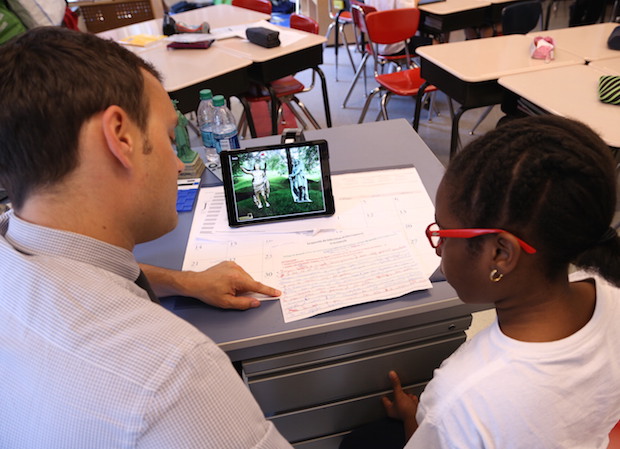
The videos also serve as a support aid for parents and other teachers by illustrating what each student is doing. “The children are often the ones who want to share their progress with their parents and teachers, because they are proud of their results.” Nurturing self-esteem makes it possible for students to reconnect with the school, a very important aspect of an educator’s work.
Teacher training, a crucial step
“Integrating technology into the classroom requires rethinking teaching methods, and this can be incredibly intimidating a priori,” says kindergarten teacher Alexandre Sivéra. “It’s like a really sophisticated Swiss Army knife that you have to learn to use,” adds Pierre Guillemard, his counterpart in third grade. Both teachers are technology ambassadors, a teacher-to-teacher training program introduced in 2014, that engages one teacher per grade and department to explore the possibilities offered by technology. The Lycée’s tech ambassadors attend conferences, exchange ideas with each other, and share research and tools with their colleagues. Recent areas of discussion have focused on iPad educational apps, organizing the classroom during a 1:1 session (one iPad per student), or using Google Drive, a student work management platform.
“Technology provides our students the opportunity to learn, collaborate and create in ways unimaginable to previous generations.” Sean Lynch, Head of School.
Teacher training is essential. Technology in education goes well beyond how to use a computer to a complete “rethinking of teaching methods, considering the best tool for successful learning of the lesson at hand, and it takes time,” emphasizes Mrs. Dershowitz. The Lycée’s digital learning department is now a four-person team, including Mrs. Dershowitz, a technology integrator for primary and for secondary, and a media integrator. They work hand-in-hand with teachers both in the classroom and also through a series of workshops, meetings, online tutorials and regular lectures.
“The time given to think and test out new approaches is so important,” says Mr. Sivera, who has a longstanding interest in new technology. He used the iPad augmented-reality app Aurasma in class and shared how he used it with his colleagues (see p.44 for an example of Aurasma at work). He is careful to emphasize that new technology does not play a dominant role in pre-school classrooms. “At this age, what matters is socialization, language, the development of motor and fine motor skills,” he says.
A virtual visit to Versailles
Indeed. Much discussion among faculty centers on balance and just how much time iPads should be used in the classrooms. For Mylène Ardid, an hour a day strikes the right balance. “I have a smaller and more targeted use of technology than I thought I would at first,” she says.
She discovered a way to make studying the reign of Louis XIV more real for fourth graders. Though her class could not visit the palace of Versailles, it was possible to take a virtual tour through Google Art Project, which provides an immersive experience for this world-renowned historic site.
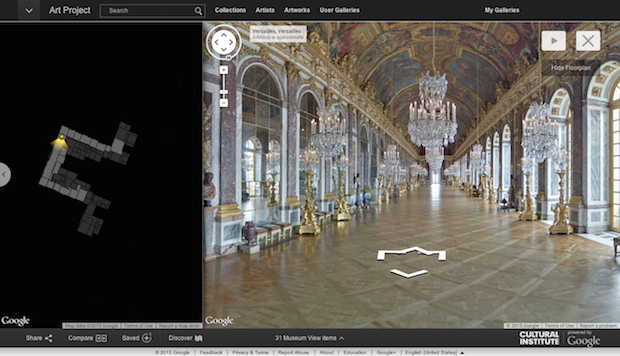
“The students were instructed to visit and describe what they saw in the Hall of Mirrors, including the works of art hanging on the walls, and in the Le Nôtre gardens,” explained Mylène Ardid enthusiastically. “No handouts or video could have been as effective as this was in making the subject come alive!”
From third to sixth grades: one iPad per student
The implementation of technology at the school has been gradual. SmartBoards began replacing black boards in some classrooms in the early 2000s, and by 2008, secondary teachers were given laptops and all primary teachers had desktop computers in the classrooms. Laptops were made available to students as needed, through circulating laptop carts that teachers could use when lessons required them.
Beginning in 2012, the school began exploring the possibility of implementing a true 1-to-1 program, in which each student has his or her own device. “The iPad was chosen for this program, because it is a more discreet tool, less intrusive than a laptop, easier to start up, and more suitable for focusing on one task at a time,” says Mrs. Dershowitz.
In January 2013, a 1-to-1 program was introduced in Sonia Rocca’s sixth-grade Italian class (see World Languages story on p. 30). Students were given their own iPads for class and were able to bring them home to do homework. At the end of the year, the results of program were clear. In understanding, speaking and reading in Italian, the sixth graders in the 1-to-1 program surpassed the previous year for the same period. “Sonia’s success reinforced our decision to develop a 1-to-1 program across the school,” says Mrs. Dershowitz.
After a year of training, in fall 2014, a 1-to-1 program was implemented in fifth grade, and at the start of 2015, all fourth, fifth and sixth grades adopted the program, with only sixth graders being allowed to bring their iPads home in the evening. In September 2016, the 1-to-1 will be extended from third to seventh grades. Once again, only Secondary school students will be allowed to bring their iPads home. Primary students will leave them locked in cabinets in the classrooms.
“We want to teach students to think of the iPad as a learning tool, and not just a game console,” Mrs. Dershowitz stressed.
Click here to read the article in LFNY Magazine.
About the Author :
Former journalist, Cecile is passionate about multimedia storytelling. With her camera, notepad and microphone, she enjoys telling the great stories that are happening at the Lycée. Cecile was formerly senior communications manager at the school.

